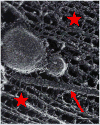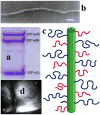Liquid crystal assemblies in biologically inspired systems
- PMID: 24558293
- PMCID: PMC3927920
- DOI: 10.1080/02678292.2013.846422
Liquid crystal assemblies in biologically inspired systems
Abstract
In this paper, which is part of a collection in honor of Noel Clark's remarkable career on liquid crystal and soft matter research, we present examples of biologically inspired systems, which form liquid crystal (LC) phases with their LC nature impacting biological function in cells or being important in biomedical applications. One area focuses on understanding network and bundle formation of cytoskeletal polyampholytes (filamentous-actin, microtubules, and neurofilaments). Here, we describe studies on neurofilaments (NFs), the intermediate filaments of neurons, which form open network nematic liquid crystal hydrogels in axons. Synchrotron small-angle-x-ray scattering studies of NF-protein dilution experiments and NF hydrogels subjected to osmotic stress show that neurofilament networks are stabilized by competing long-range repulsion and attractions mediated by the neurofilament's polyampholytic sidearms. The attractions are present both at very large interfilament spacings, in the weak sidearm-interpenetrating regime, and at smaller interfilament spacings, in the strong sidearm-interpenetrating regime. A second series of experiments will describe the structure and properties of cationic liposomes (CLs) complexed with nucleic acids (NAs). CL-NA complexes form liquid crystalline phases, which interact in a structure-dependent manner with cellular membranes enabling the design of complexes for efficient delivery of nucleic acid (DNA, RNA) in therapeutic applications.
Keywords: DNA; Neurofilaments; RNA; gyroid cubic phases; hexagonal liquid crystals; lamellar liquid crystals; lipids; nematic hydrogels; small-angle-x-ray-scattering (SAXS).
Figures







Similar articles
-
Neurofilament sidearms modulate parallel and crossed-filament orientations inducing nematic to isotropic and re-entrant birefringent hydrogels.Nat Commun. 2013;4:2224. doi: 10.1038/ncomms3224. Nat Commun. 2013. PMID: 23892390
-
Neurofilament networks: Salt-responsive hydrogels with sidearm-dependent phase behavior.Biochim Biophys Acta. 2016 Jul;1860(7):1560-9. doi: 10.1016/j.bbagen.2016.03.018. Epub 2016 Mar 16. Biochim Biophys Acta. 2016. PMID: 26993199
-
Interplay between liquid crystalline and isotropic gels in self-assembled neurofilament networks.Biophys J. 2008 Jul;95(2):823-35. doi: 10.1529/biophysj.107.127415. Biophys J. 2008. PMID: 18583309 Free PMC article.
-
Cationic liposome-nucleic acid nanoparticle assemblies with applications in gene delivery and gene silencing.Philos Trans A Math Phys Eng Sci. 2016 Jul 28;374(2072):20150129. doi: 10.1098/rsta.2015.0129. Philos Trans A Math Phys Eng Sci. 2016. PMID: 27298431 Free PMC article. Review.
-
Cationic Liposomes as Vectors for Nucleic Acid and Hydrophobic Drug Therapeutics.Pharmaceutics. 2021 Aug 30;13(9):1365. doi: 10.3390/pharmaceutics13091365. Pharmaceutics. 2021. PMID: 34575441 Free PMC article. Review.
Cited by
-
Label-Free Detecting of the Compaction and Decompaction of ctDNA Molecules Induced by Surfactants with SERS Based on a nanoPAA-ZnCl2-AuLs Solid Substrate.ACS Omega. 2020 Jan 7;5(2):1109-1119. doi: 10.1021/acsomega.9b03294. eCollection 2020 Jan 21. ACS Omega. 2020. PMID: 31984267 Free PMC article.
-
Optimizing cationic and neutral lipids for efficient gene delivery at high serum content.J Gene Med. 2014 Mar-Apr;16(3-4):84-96. doi: 10.1002/jgm.2762. J Gene Med. 2014. PMID: 24753287 Free PMC article.
-
Glucosylceramide Associated with Gaucher Disease Forms Amyloid-like Twisted Ribbon Fibrils That Induce α-Synuclein Aggregation.ACS Nano. 2021 Jul 27;15(7):11854-11868. doi: 10.1021/acsnano.1c02957. Epub 2021 Jul 2. ACS Nano. 2021. PMID: 34213307 Free PMC article.
-
Lipid-based Liquid Crystalline Films and Solutions for the Delivery of Cargo to Cells.Liq Cryst Rev. 2019;7(2):167-182. doi: 10.1080/21680396.2019.1666752. Epub 2019 Nov 4. Liq Cryst Rev. 2019. PMID: 31942262 Free PMC article.
-
Lipid Cubic Mesophases Combined with Superparamagnetic Iron Oxide Nanoparticles: A Hybrid Multifunctional Platform with Tunable Magnetic Properties for Nanomedical Applications.Int J Mol Sci. 2021 Aug 27;22(17):9268. doi: 10.3390/ijms22179268. Int J Mol Sci. 2021. PMID: 34502176 Free PMC article.
References
-
- Kandel ER, Schwartz JH, Jessell TM. Principles of Neural Science. 4th. McGraw Hill; New York: 2000.
-
- Peters A, Palay SL, Def H. The Fine Structure of the Nervous System. 3rd. Webster; New York: 1991.
-
- Burgoyne RD, editor. The Neuronal cytoskeleton. Wiley & Sons; New York: 1991.
-
- Hirokawa N. In: The Neuronal Cytoskeleton. Burgoyne RD, editor. Wiley; New York: 1991. pp. 5–74.
Grants and funding
LinkOut - more resources
Full Text Sources
Other Literature Sources
Miscellaneous
